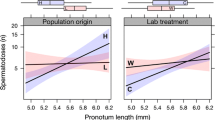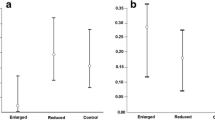Abstract
The inter-populational variation in the reproductive behaviour of the peacock blenny Salaria pavo (Risso 1810), particularly the influence of the ecologic environment, was reviewed in the present work. Two populations of this species inhabiting contrasting environments were studied: the Ria Formosa population, a coastal lagoon with sandy/muddy substrate located in the south of Portugal, and the Gulf of Trieste, an area presenting rocky substrate located in the northern Adriatic sea. The remarkable differences in the mating system and reproductive behaviour between the two populations (namely sex-role reversal and high frequency of alternative reproductive tactics (ARTs) at the Ria Formosa vs typical sex roles and low frequency of ARTs at the Gulf of Trieste) are interpreted as a plastic behavioural and physiological response to contrasting ecological conditions. Androgens, namely 11-ketotestosterone, seem to act as mediators of this response. The expression and activity of the enzyme aromatase in the brain also seems to play a key role in fine-tuning the behavioural output in all male morphs as well as females.


Similar content being viewed by others
References
Almada VC, Gonçalves EJ, Santos AJ, Baptista C (1994) Breeding ecology and nest aggregation in a population of Salaria pavo (Pisces: Blenniidae) in an area where nest sites are very scarce. J Fish Biol 45:819–830
Almada VC, Gonçalves EJ, Oliveira RF, Santos AJ (1995) Courting females: ecological constraints affect sex roles in a natural population of the blenniid fish Salaria pavo. Anim Behav 49:1125–1127
Forsgren E, Amundsen T, Borg AA, Bjelvenmark J (2004) Unusually dynamic sex roles in a fish. Nature 429:551–554
Gonçalves DM, Teles M, Alpedrinha Jo, Oliveira RF (2008) Brain and gonadal aromatase activity and steroid hormone levels in female and polymorphic males of the peacock blenny Salaria pavo. Horm Behav. doi:10.1016/j.yhbeh.2008.07.014
Gonçalves EJ, Almada VC, Oliveira RF, Santos AJ (1996) Female mimicry as a mating tactic in males of the blenniid fish Salaria pavo. J Mar Biol Assoc UK 76:529–538
Gonçalves D, Fagundes T, Oliveira RF (2003a) Reproductive behaviour of sneaker males of the peacock blenny. J Fish Biol 63:528–533
Gonçalves D, Oliveira RF, Korner K, Schlupp I (2003b) Intersexual copying by sneaker males of the peacock blenny. Anim Behav 65(2):355–361
Gonçalves D, Saraiva JL, Teles M, Oliveira R (2010) Brain aromatase mRNA expression in two populations of the peacock blenny Salaria pavo with divergent mating systems. Horm Behav 57(2):192–197
Gowaty PA, Hubbell SP (2005) Chance, time allocation, and the evolution of adaptively flexible sex role behavior. Integr Comp Biol 45(5):931–944. doi:10.1093/icb/45.5.931
Oliveira RF, Gonçalves DM (2008) Hormones and social behaviour of teleost fish. In: Magnhagen C, Braithwaite VA, Forsgren E, Kapoor BG (eds) Fish behaviour. Science Publishers Inc., Enfield
Oliveira RF, Almada VC, Forsgren E, Gonçalves EJ (1999) Temporal variation in male traits, nesting aggregations and mating success in the peacock blenny. J Fish Biol 54:499–512
Oliveira RF, Gonçalves D, Ros AFH (2009) Evolution and development of alternative reproductive tactics in blennies: a tale of two species. In: Patzner RA, Gonçalves E, Hastings P, Kapoor BG (eds) The biology of blennies. Science Publishers Inc., Enfield
Papaconstantinou CA (1979) Secondary sex characters of blennioid fishes (Pisces: Blenniidae). Thalassographica 3:57–75
Patzner RA, Seiwald M, Adlgasser M, Kaurin G (1986) The reproduction of Blennius pavo (Teleostei, Blenniidae) V. Reproductive behavior in natural environment. Zool Anz 216(5/6):338–350
Saraiva JL, Barata EN, Canário AVM, Oliveira RF (2009) The effect of nest aggregation on the reproductive behaviour of the peacock blenny Salaria pavo (Risso). J Fish Biol 74:754–762
Saraiva JL, Gonçalves DM, Oliveira RF (2010) Environmental modulation of androgen levels and secondary sex characters in two populations of the peacock blenny Salaria pavo. Horm Behav 57(2):192–197
Saraiva JL, Pignolo G, Gonçalves D, Oliveira R (2012) Interpopulational variation of the mating system in the peacock blenny Salaria pavo. Acta Ethol 15(1):25–31. doi:10.1007/s10211-011-0104-y
Saraiva JL, Gonçalves DM, Simões M, Oliveira RF (2011) Plasticity in reproductive behaviour in two populations of the peacock blenny Salaria pavo. Behaviour 148(14):1457–1472
Acknowledgments
JLS was funded by a Fundação para a Ciência e Tecnologia grant SFRH/BPD/67008/2009.
Author information
Authors and Affiliations
Corresponding author
Rights and permissions
About this article
Cite this article
Saraiva, J.L., Gonçalves, D. & Oliveira, R.F. Ecological modulation of reproductive behaviour in the peacock blenny: a mini-review. Fish Physiol Biochem 39, 85–89 (2013). https://doi.org/10.1007/s10695-012-9658-5
Received:
Accepted:
Published:
Issue Date:
DOI: https://doi.org/10.1007/s10695-012-9658-5




